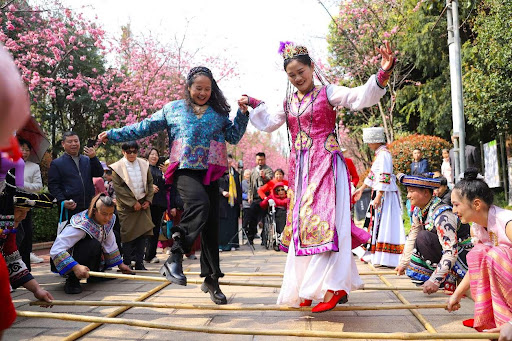Foreign
To experience rural life in Tonglu

Foreign
Golden mangoes fuel booming industry in Lijiang

By Yang Wenming, People’s Daily
Strolling through Huaping County in Lijiang, southwest China’sYunnan province, visitors are met with expansive mango plantations stretching across rolling hills. Statistics reveals that nearly 100,000 localresidentsparticipate in the mango industry, now established as the region’s foremost economic pillar.
“Selecting appropriate cultivars forms the foundation of premium mango cultivation,” said Zhang Guohui, director of the Huaping county mango industry development center.
The mid-season Lijiang Red Mango, a locally adapted variety, retails at 5-6 yuan ($0.69-0.83) per 500 grams due to its balanced sweetness and vibrant appearance. Zhang noted that trial cultivation of this variety began in 2006, but substantial market adoption only occurred within the past two to three years.
To align with evolving market demands, the county has implemented a three-pronged strategy: optimizing existing mango varieties, introducing market-responsive cultivars, and providing systematic training programs for farmers.
Chen Xingqin, a cultivator from Guozishan village in Rongjiang township, manages dual mango varieties.In an interview with People’s Daily, he explained, “Multiple varieties complicate farm management, yet monoculture exposes growers to financial instability during price fluctuations.”
Quality remains paramount for market success. “As mango cultivation constitutes the primary income source for numerous Huaping farmers, they demonstrate strong commitment to orchard management investments,” Zhang observed. He further quantified this impact: divergent management practices create yield and quality variations that translate to three-to-fourfold differences in per-mu (667 m²) output value.
In recent years, Huaping has enacted comprehensive quality enhancement measures, including conservation of elite germplasm resources, soil fertility maintenance protocols, modernized cultivation techniques, and strategic reductions in chemical inputs and orchard density.
Brand development further elevates product value. While wholesale mangoes typically fetch 2 yuan per 500 grams at farm gates, meticulous sorting and packaging substantially increase market prices. “Standardized grading and enhanced quality control enable premium pricing,” affirmed Zou Jie, general manager of a local mango enterprise.
In recent years, Huaping county has prioritized brand-building initiatives for “Lijiang Mango” to elevate recognition and market reputation for its locally grown produce. Sustained high-quality development of the industry, however, hinges on advancing critical infrastructure such as cold chain logistics, storage facilities, and value-added processing technologies. While early efforts focused on basic dried mango production, the sector has since diversified into refined products like mango pulp and derivatives, expanding the industrial chain and boosting profitability.
According to official statistics, Huaping’s mango-related agricultural output surged to 3.05 billion yuan ($421 million) in 2024, driven by the county’s signature golden mangoes that continue to anchor the industry’s robust growth.
Foreign
Yunnan province: elevating tourism through natural splendor and innovation

By Zhu Sixiong, Yang Wenming,People’s Daily
Renowned for its breathtaking landscapes and rich cultural heritage, Yunnan province in southwest China has long captivated global travelers.. From the serene vistas of Cangshan Mountain and Erhai Laketo the surreal karst formations of Stone Forest and the tranquil Cuihu Park, the region offers a diverse mosaic of natural wonders and immersive cultural experiences.
In recent years, Yunnan has prioritized the high-quality development of its tourism sector by capitalizing on its unique resources, adapting to evolving consumer preferences, diversifying offerings, and enhancing market governance.
Yunnan’sinnovative tourism initiatives harness its ecological treasures.In the Gaoligong Mountain, visitors embark on leisurely hikes while exploring its abundant wild mushroom ecosystems. Wang Jiao, a traveler from afar, shared her experience: “The forest air is invigorating! We not only foraged mushrooms but also gained insights into the area’s remarkable biodiversity.”
Building on its natural assets, the province actively promotes biodiversity-themed tourism, curating specialized routes such as the rainforests of Xishuangbanna, the ancient tea forests of Jingmai Mountain in Pu’er, and the paleontological wonders of Chengjiang’s fossil sites.
Yunnan is also crafting novel tourism scenarios to meet shifting demands. By integrating technology, cultural storytelling, and sustainable practices, the province is redefining travel experiences—from eco-friendly homestays in rural villages to interactive heritage tours in historic towns. This forward-thinking approach ensures Yunnan remains a dynamic destination while preserving its ecological and cultural integrity.
Along the shore of Erhai Lake in Dali Bai autonomous prefecture, newlyweds capturetimeless moments against the picturesque backdrop, while by Dianchi Lake in Kunming, Yunnan’s provincial capital, travelers relish serene encounters with the region’s iconic red-billed gulls. Further north in Diqing Tibetan autonomous prefecture, adventure seekers test their limits on rugged trails, surrounded by awe-inspiring natural vistas.These scenes reflect the rapid growth of niche tourism sectors such as wedding photography, vlog-friendly destinations, wellness retreats, and sports tourism, all of which are diversifying Yunnan’s appeal through personalized, experiential offerings.
To cater to rising demand for high-quality, multifaceted travel experiences, Yunnan has strategically developed rural tourism, cross-border itineraries, educational tours, and wellness programs, each tailored to local cultural and ecological strengths. In Lijiang ancient town, visitors are enveloped in the melodies of Naxi ancient music and the rhythmic Leba dance, while shops showcase postcards, notebooks, and handicrafts adorned with Naxi pictographs—tangible souvenirs of a “Yunnan memory.”
Cultural heritage and living traditions now define Yunnan’s tourism identity. The Torch Festival in Chuxiong, Tengchong’s vibrant Simola “village gala,” and Jianshui’s pottery workshops invite travelers to engage directly with local customs. Across the province, intangible cultural heritage is seamlessly woven into tourism, creating immersive encounters at every turn.
“Yunnan is boasts 777 nationally recognized traditional villages, 6UNESCO World Heritage Sites, and 8 national historical and cultural towns,”emphasized Zhao Guoliang, director of the Yunnan Provincial Department of Culture and Tourism. He noted that the province is deepening the fusion of culture and tourism by leveraging its natural landscapes, ethnic diversity, and artisanal industries. From live performances to everyday interactions, cultural elements enrich dining, lodging, shopping, and entertainment, offering visitors an organic connection to Yunnan’s heritage.
To ensure seamless travel experiences, Yunnan has prioritized market regulation and service quality improvements. In 2024, the province achieved a tourism revenue of 1.14 trillion yuan ($157.28 billion) and welcomed 3.9 million long-stay visitors, marking a 20.7% year-on-year increase—a testament to its growing reputation as a world-class destination where nature, culture, and innovation converge.
Foreign
Dynamic factors drive China’s thriving innovation

By Li Zheng, People’s Daily
At first glance, seemingly unrelated phenomena may unveil converging trends when examined through an innovative lens.
This spring, two developments have captured public attention: Hangzhou’s “Six Little Dragons”—a group of pioneering tech enterprises in east China’sZhejiang province—have sparked nationwide enthusiasm for technological advancement, while the animated blockbuster Ne Zha 2 has secured its place among the highest-grossing films in global cinema history. Though technology and animation initially appear disparate—the former representing scientific frontiers, the latter showcasing China’s cultural creativity—both fundamentally thrive on innovation.
Historically,China’s innovation landscape has been dominated by its eastern regions. Yet the rise of Ne Zha 2, produced in Chengdu, southwest China’s Sichuan province, raises a critical question: Is this an isolated success story, or does it signify broader progress in central and western regions under China’s innovation-driven development strategy?
A closer examination reveals a surge of breakthroughs across central and western China: Henan’s Pangdonglai supermarket chain has revolutionized retail through disruptive business models; Anhui has emerged as a hub for quantum computing and new energy vehicle technologies; Xinjiang now hosts the world’s longest desert railway and most extensive sand-control greenbelt. When viewed collectively, these achievements highlight a narrowing innovation gap between eastern and central-western regions.
This transformative shift stems largely from China’s accelerated development of a unified national market. The country’s world-leading infrastructure—encompassing high-speed rail, expressways, and logistics networks—has effectively compressed geographical distances. Meanwhile, universal 5G coverage at the county level and broadband access in every village, coupled with 5G’s representing over 60% of mobile subscribers, have turbocharged information flows.
Complementing these advancements, the elimination of regional trade barriers and standardization of market regulations have fostered nationwide fair competition. Together, these measures create an ecosystem where innovation transcends geographical boundaries, enabling coordinated development across China’s diverse regions.
The establishment of a unified domestic market and the unimpeded “dual circulation” framework have facilitated the seamless allocation of resources and production factors. Valuable innovations now overcome geographical barriers, drawing capital and expertise nationwide—and even globally—while capitalizing on China’s vast market advantages.
Traditional constraints tied to geographic location and transportation infrastructure are diminishing, unleashing latent developmental potential in central and western regions and catalyzing unprecedented innovation momentum. Cross-regional innovation collaboration has intensified significantly. Along the Chaobai River basin spanning Beijing, Tianjin, and Hebei province, entrepreneurs from Beijing increasingly invest in Tianjin and Hebei, while industrial components from these areas steadily supply Beijing’s Economic-Technological Development Area.
In Hubei province, the Optics Valley Sci-tech Innovation Corridor exemplifies integrated advancement: Wuhan drives R&D breakthroughs, Ezhou spearheads commercialization, and neighboring cities specialize in manufacturing—showcasing how regional synergy accelerates shared technological progress..
Such coordinated innovation strategies optimize spatial resource distribution, generate multiplicative synergies, and narrow regional innovation disparities. As physical boundaries dissolve, ambitious visions now transcend geographical divides. Recent years have seen institutions from Ningxia Hui autonomous region establish innovation hubs in Beijing, Shanghai, and Shenzhen, leveraging premium resources to pioneer East-West tech collaboration frameworks. Notably, a Ningxia-based organic pigment manufacturer secured a nearly$200,000 contract via the Ningxia-Shanghai Sci-Tech Innovation Center, marking its successful entry into Europe’s automotive coatings market.
The consolidation of a national unified market has amplified market scalability and industrial resilience. Enterprises and innovators nationwide now access cross-regional networks seamlessly. As innovation evolves into a collective, nationwide pursuit—fueled by collaborative specialization—it promises to yield transformative breakthroughs that redefine industrial frontiers.
-

 News4 hours ago
News4 hours agoSultan of Sokoto asks Muslims to look out for new moon ahead of Eid celebration
-

 News3 hours ago
News3 hours agoInsecurity: Army dismantles 16 illegal refinery sites in Niger Delta, arrests 11 oil thieves
-

 News3 hours ago
News3 hours agoChinese firm not involved in Nigerian Immigration officer’s shooting – DG
-

 News3 hours ago
News3 hours agoFG to hold dialogue on power in health sector, inaugurates committee
-

 News3 hours ago
News3 hours agoOndo Niger Delta women to Tinubu: End marginalization in Ilaje oil-producing areas





